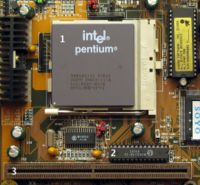
Cache on a stick
Encyclopedia


Static random access memory
Static random-access memory is a type of semiconductor memory where the word static indicates that, unlike dynamic RAM , it does not need to be periodically refreshed, as SRAM uses bistable latching circuitry to store each bit...
used as an L2 cache
CPU cache
A CPU cache is a cache used by the central processing unit of a computer to reduce the average time to access memory. The cache is a smaller, faster memory which stores copies of the data from the most frequently used main memory locations...
in a computer. COASt modules look like somewhat over-sized SIMM
SIMM
A SIMM, or single in-line memory module, is a type of memory module containing random access memory used in computers from the early 1980s to the late 1990s. It differs from a dual in-line memory module , the most predominant form of memory module today, in that the contacts on a SIMM are redundant...
modules. These modules were somewhat popular in the Apple and PC platforms during early to mid-1990s, but with newer computers cache is built into either the CPU
Central processing unit
The central processing unit is the portion of a computer system that carries out the instructions of a computer program, to perform the basic arithmetical, logical, and input/output operations of the system. The CPU plays a role somewhat analogous to the brain in the computer. The term has been in...
or the motherboard
Motherboard
In personal computers, a motherboard is the central printed circuit board in many modern computers and holds many of the crucial components of the system, providing connectors for other peripherals. The motherboard is sometimes alternatively known as the mainboard, system board, or, on Apple...
. COASt modules decoupled the motherboard from its cache, allowing varying configurations to be created. A low-cost system could run with no cache, while a more expensive system could come equipped with 512 KB or more cache. Later COASt modules were equipped with pipelined-burst SRAM
Static random access memory
Static random-access memory is a type of semiconductor memory where the word static indicates that, unlike dynamic RAM , it does not need to be periodically refreshed, as SRAM uses bistable latching circuitry to store each bit...
.
The standard was originally defined by Motorola
Motorola
Motorola, Inc. was an American multinational telecommunications company based in Schaumburg, Illinois, which was eventually divided into two independent public companies, Motorola Mobility and Motorola Solutions on January 4, 2011, after losing $4.3 billion from 2007 to 2009...
to be between 4.33 and 4.36 inches (110 and 111 mm) wide, and between 1.12 and 1.16 inches (28 and 29 mm) high. It could be found in many Apple Macintosh
Macintosh
The Macintosh , or Mac, is a series of several lines of personal computers designed, developed, and marketed by Apple Inc. The first Macintosh was introduced by Apple's then-chairman Steve Jobs on January 24, 1984; it was the first commercially successful personal computer to feature a mouse and a...
in the early-to-mid-90s, but disappeared as the Mac moved to the PowerPC
PowerPC
PowerPC is a RISC architecture created by the 1991 Apple–IBM–Motorola alliance, known as AIM...
platform.
Intel
Intel Corporation
Intel Corporation is an American multinational semiconductor chip maker corporation headquartered in Santa Clara, California, United States and the world's largest semiconductor chip maker, based on revenue. It is the inventor of the x86 series of microprocessors, the processors found in most...
also used the COASt standard for their Pentium systems, where it could be found as late as 1998 in Pentium MMX systems utilizing Intel chipsets such as 430VX and 430TX. Later, Intel combined this architecture with the CPU and created the Slot 1
Slot 1
Slot 1 refers to the physical and electrical specification for the connector used by some of Intel's microprocessors, including the Pentium Pro, Celeron, Pentium II and the Pentium III...
CPU cartridge which contained both the CPU and separate cache chips.
The slot that the COASt module plugged into was named "CELP", or "card edge low profile", referring to the small circuit board and the conductors on its edge.

